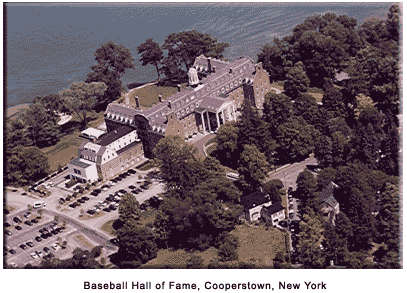"Preserving History, Honoring Excellence, Connecting Generations"
Every kid who has ever played catch with his dad, every kid who has ever played in a sandlot pickup game for hours on end, every kid who has ever played T-ball or in the Pee Wee leagues, every kid who has experienced his first crack of the bat, every kid who has devoured the daily box scores of his favorite team and can recite the top-ten batting averages for the National League, has heard of Cooperstown, and has dreamed of the day his name would be included alongside the names of Babe Ruth, Hank Aaron, Ty Cobb, and Willie Mays, in the Baseball Hall of Fame — or the more formal and totally unromantic, "National Baseball Hall of Fame and Museum."
The Beginning
The sleepy little town of Cooperstown, New York, is located at the south end of Otsego Lake in upstate New York, west of Albany, the state capital, and southeast of Syracuse. The community has a population of about 2,000 hardy and hearty souls.
Damaged by the Depression of the early 1930s, as well as Prohibition, which destroyed the thriving hops industry, town fathers gathered to find a way to pump up the economy. They decided that a return of tourists would help start the ball rolling.
There was a long-standing myth that Abner Doubleday had invented baseball in a cow pasture in Cooperstown between battles during the Civil War. What greater way to keep that legend alive, and lure people to town, than by establishing an institution honoring the stars of the game?
The Clark Foundation, a local charitable organization established by the Singer Sewing Machine Company, provided the bulk of the funding for the project and, on June 12, 1939, the Baseball Hall of Fame became a reality. The Hall would honor and enshrine only those players, managers, umpires, and promoters of the game who had risen, like top-quality cream, to the top of their game.
Major League Baseball took notice of the project early on and decided the Hall would be a perfect fit for their marketing department. They provided the first players to be honored when Cobb, Ruth, Honus Wagner, Christy Mathewson, and Walter Johnson were elected to the Hall of Fame in 1936, three years before the actual building was ready. All five had received at least 75 percent of the vote on ballots sent out to members of the Baseball Writers` Association of America (BBWAA). Members with at least 10 years in the association are able to vote for a maximum of 10 players thought to be worthy of consideration.
 The Hall Becomes a National Shrine
The Hall Becomes a National Shrine
By the time the building was ready in 1939, baseball had elected more players, as well as pioneers of the game, for induction. Players included such household names as Nap Lajoie, Tris Speaker, Cy Young (all elected in 1937); Pete Alexander (1938); Cap Anson, Eddie Collins, Lou Gehrig, "Wee Willie" Keeler, and George Sisler (1939).
Among the pioneers of baseball enshrined in that first induction into the Hall were Alexander Cartwright, actual inventor of the game; Ban Johnson, first president of the American League; Morgan G. Bulkeley, first president of the National League; Connie Mack, owner and manager of the Phildelphia Ahtletics; John McGraw, gruff-and-tough manager of the New York Giants; Charles Comiskey, owner of the Chicago White Sox; and Albert Spalding, innovator of improved baseball equipment, including gloves, bats, and balls.
Babe Ruth opened the ceremonies that day in 1939 by telling the crowd,
"They started something here and the kids are keeping the ball rolling. I hope some of you kids will be in the Hall of Fame. I`m very glad that in my day I was able to earn my place. And I hope youngsters of today have the same opportunity to experience such feeling."
Following Ruth, Commissioner Kenesaw Mountain Landis proclaimed, "I now declare the National Baseball Museum and the Baseball Hall of Fame in Cooperstown, New York — home of baseball — open!"
After the ceremony, two teams of all-stars managed by Honus Wagner and Eddie Collins — with players representing each of Major League Baseball`s 16 teams — played a game at Doubleday Field in the first-ever Hall of Fame Game.
Dubbed the "Cavalcade of Baseball," June 12 was the crowning day of a four-month celebration of the 100th anniversary of baseball in Cooperstown in 1939. That day, the United States Post Office issued a special commemorative stamp as part of the celebration, with a million of them being sold in Cooperstown.
The Hall
As of January 2021, 340 individuals have a plaque grace those hallowed walls in Cooperstown, comprising players, executives/pioneers, and umpires. Each of them, as they took the podium to address their avid followers, not only exhibited a mastery of the game, but became bigger-than-life idols of the ages.
For all that remember the smell of new-mown grass, the aroma of hot dogs and popcorn wafting through the late-Spring air, the playing of the National Anthem, the bellowing of the loud speaker announcing the next batter, the chasing after that coveted foul ball into the stands, the clattering melody of baseball cleats meeting concrete in the dugout, the titillating call of the home team radio broadcaster describing our hero`s towering home run, the 7th-inning stretch, the rapturous, gut-wrenching feeling in the bottom of the 9th with the game on the line and the clean-up hitter coming to the plate - for all that remember, Cooperstown beckons.
There is also a Softball Hall of Fame. Softball equipment differs from baseball equipment and the rules are considerably different. Softball is entirely an amateur sport and in its organized, competitive form, entirely female.